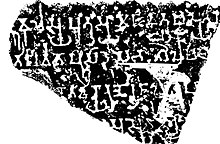
A | B | C | D | E | F | G | H | CH | I | J | K | L | M | N | O | P | Q | R | S | T | U | V | W | X | Y | Z | 0 | 1 | 2 | 3 | 4 | 5 | 6 | 7 | 8 | 9
| Mountain Temple inscription | |
|---|---|
 Ancient Sanskrit inscription Indian Museum, Kolkata | |
| Writing | Sanskrit |
| Created | ~ 1st Century CE |
| Place | Mathura, Uttar Pradesh |
| Present location | Indian Museum, Kolkata |
| Identification | NS 6482 |
The Mountain Temple inscription was found near Mathura, India. It is on a broken slab, and now housed at the Indian Museum, Kolkata.[1][2]
The Mountain Temple inscription makes an early mention of Hindu and Jain temple architecture, where its shape is described to be like a mountain and accompanied with an assembly hall (sabha). The inscription's wording and arrangement, state Luders and Janert, closely resembles the Mora Well inscription, now in Mathura museum. Both describe a donation of a stone temple, halls and slabs; however, the Mora Well inscription is more detailed and mentions pratima. The Rajula in line 3 of the Mountain Temple inscription is likely the Northern Satraps Great Satrap Rajuvula, found in Mathura lion capital.[2]
The Mountain Temple inscription lacks a date. The similar Mora Well Inscription is dated to the early decades of the 1st-century CE and is related to early Vaishnavism: the Mora Well inscription mentions stone shrines dedicated to five Vrishni heroes.[3]
Inscription
The discovered inscription is incomplete, in not quite correct Sanskrit.[2] It reads:[1]
1. . . . uvulasya putrasya mahaksatrapasya so ...
2. . . . ti parvato prasade(or do) sabha silapata ...
3. . . . taviryo rane rajulas ca pi ...
4. . . . sasyedam arca ...
Translation
Sonya Quintanilla translates it as,[1]
. . . of the mahaksatrapasya So(dasa), son of (Raj)uvula . . .
a temple like a mountain, an assembly hall, stone slabs...
whose heroism in battle, and (his) father Rajula . . .
this . . . of his is adored.
References
- ^ a b c Sonya Rhie Quintanilla (2007). History of Early Stone Sculpture at Mathura: Ca. 150 BCE - 100 CE. BRILL Academic. p. 260. ISBN 90-04-15537-6.
- ^ a b c Heinrich Lüders and Klaus Ludwig Janert (1961), Mathurā inscriptions, Göttingen : Vandenhoeck & Ruprecht, OCLC 717966622, pages 203-204, 154, image on page 318
- ^ Doris Srinivasan (1997). Many Heads, Arms, and Eyes: Origin, Meaning, and Form of Multiplicity in Indian Art. BRILL Academic. pp. 211–214, 308-311 with footnotes. ISBN 90-04-10758-4.
Text je dostupný za podmienok Creative Commons Attribution/Share-Alike License 3.0 Unported; prípadne za ďalších podmienok. Podrobnejšie informácie nájdete na stránke Podmienky použitia.
Antropológia
Aplikované vedy
Bibliometria
Dejiny vedy
Encyklopédie
Filozofia vedy
Forenzné vedy
Humanitné vedy
Knižničná veda
Kryogenika
Kryptológia
Kulturológia
Literárna veda
Medzidisciplinárne oblasti
Metódy kvantitatívnej analýzy
Metavedy
Metodika
Text je dostupný za podmienok Creative
Commons Attribution/Share-Alike License 3.0 Unported; prípadne za ďalších
podmienok.
Podrobnejšie informácie nájdete na stránke Podmienky
použitia.
www.astronomia.sk | www.biologia.sk | www.botanika.sk | www.dejiny.sk | www.economy.sk | www.elektrotechnika.sk | www.estetika.sk | www.farmakologia.sk | www.filozofia.sk | Fyzika | www.futurologia.sk | www.genetika.sk | www.chemia.sk | www.lingvistika.sk | www.politologia.sk | www.psychologia.sk | www.sexuologia.sk | www.sociologia.sk | www.veda.sk I www.zoologia.sk


